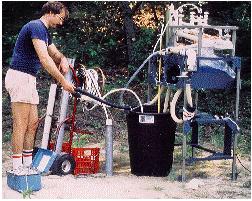 Bacteria Contaminant Interactions
Bacteria Contaminant InteractionsRonald W. Harvey U.S. Geological Survey, National Research Program
From this page
you can get a description of our current
activities, get a listing of recent publications
and
link other USGS sites.
EMAIL Contacts
Project member (P) or
Collaborator (C) email:
Last Update 01/24/03
by BIKEDOG WEBPAGES
PROJECT NUMBER: CR-94-327
PROJECT CHIEF: Ronald Harvey
SHORT TITLE: Bacteria-Contaminant Interactions
PROJECT TITLE: Interaction of Bacteria with Environmental Contaminants and Solid Surfaces in the Aquatic Environment
PROBLEM:
Although efforts have been made to explain
the behavior of heavy metals and refractory organic contaminants in aquatic
habitats in the framework of known geophysical and geochemical processes,
much remains to be learned about the role of bacteria in such behavior.
Of particular interest are bacteria-contaminant interactions in ground
water. Due to the persistence of some contaminants in the subsurface environment
and to increasing demand for both high quality ground-water and on-land
disposal of toxic chemicals and radioisotopes, these interactions should
remain important environmental problems for the next few decades. Since
significant biotransformation/biodegradation of many environmental contaminants
in aquifers and particle-laden surface waters can occur at particle surfaces,
explanations for bacteria-contaminant interactions in such environments
should take the presence of particles into account.
OBJECTIVES:
Provide some of the microbiological information
necessary for more realistic predictions of contaminant behavior in aquatic
environments. Obtain information on specific mechanisms of interactions
between environmental contaminants and aquatic bacteria, taking into account
adsorption, active uptake competition, biotransformation reactions, interactions
with extracellular polymers, effects of nutrient and physicochemical gradients,
and effects of particle surfaces. Investigate the effect of nutrient and
physicochemical conditions upon subsurface transport of bacteria since
the role of bacterial transport upon the fate of environmental contaminants
in ground water is unknown.
APPROACH:
The complex nature of interactions between
bacteria and organic and inorganic contaminants in particle-laden aquatic
habitats necessitates an approach involving both field and laboratory studies:
(1) Study of the influence of surfaces and interfaces upon microbial heterotrophic
activity in particle-laden aquatic environments, including fresh-water
aquifers. (2) Study of the effect of organic contaminants upon the distribution,
transport, and activity of the bacterial population in ground-water habitats.
These studies will be performed with Richard Smith, Water Resources Division
(WRD), Boulder. (3) Flow-through column experiments to assess the role
of adherent bacteria upon the mobility of selected heavy metals and toxic
organic compounds in simulated aquifer environments. Columns will be used
to investigate factors affecting the movement of bacteria through porous
media. (4) Microcosm studies of bacteria-contaminant interactions.
